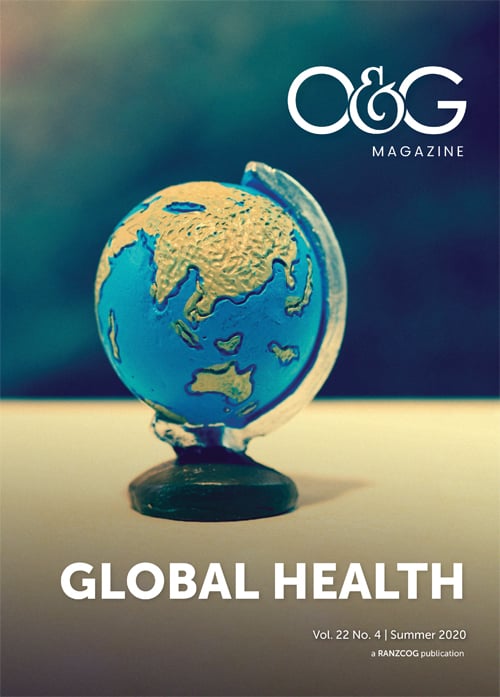Improving access to contraception is one of the safest and most cost-effective methods for lowering maternal morbidity and mortality, so much so that expanding access to reliable contraception for women has become an international priority of the Sustainable Development Goals for the coming decade.1 2 3 4 5 However, the impact of family planning on maternal health has not been comprehensively outlined for the Asia-Pacific Region where approximately 13,000 maternal deaths continue to occur each year, representing nearly 5% of the annual global maternal mortality burden.6
Papua New Guinea (PNG) is an archipelago nation with the highest maternal mortality ratio of all countries outside of Africa, estimated between 250 and 700 per 100,000 live births in 2014, depending on regional rurality.7 8 Although contraceptive prevalence among married women aged 15–49 years in PNG has increased from 24.5% in 1990 to 36.5% in 2016, in rural areas it is much lower, especially for modern methods (21%). This is significant because 85% of PNG’s population are rurally dwelling and the majority (>90%) of maternal deaths occur in these locations. The total unmet need for contraception in rural areas also remains high at 44% with little change in the preceding decade.9 10 11
Long-acting reversible contraception (LARC), including contraceptive implants and intra-uterine devices, have been consistently shown in the literature to be the most cost-effective, safe and reliable methods of contraception to limit pregnancy exposure and achieve adequate birth spacing.12 13 Access to LARC, however, remains heavily limited in PNG owing to a complex interplay of logistic, social and cultural barriers.14 15 16 17 Outreach programs co-ordinated by non-government organisations, including Rotary Australia International and Marie Stopes International, in association with volunteer and local health services in PNG, have tried to alleviate some of the access barriers by bringing the implant services to the communities.18 These programs educate women about the implants, insert them free of charge and train local health workers in insertion and removal techniques to promote capacity building and program sustainability.19
RANZCOG is committed to improving reproductive health in the Asia-Pacific Region and actively promotes and facilitates volunteer networks that link doctors across Australia, New Zealand and the Pacific, with a particular emphasis on enhancing support at the grassroots level.20 Since 2012, a number of RANZCOG representatives have been involved in outreach programs that have provided over 80,000 contraceptive implants to women in 12 rural provinces throughout PNG. Supported by the RANZCOG New South Wales Regional Committee Trainee Research Scholarship, we set out to evaluate the clinical efficacy and cultural acceptability of implants within a locally serviced rural population on Karkar Island, and the impact that introduction of implants has had on maternal and neonatal health in this setting.
Findings
We used both qualitative and quantitative methods to examine the acceptability of receiving implants through this program, as well as follow up the women and the community to document the ongoing use of implants, and assess the impact that increasing access to reliable contraception had on maternal and neonatal health. Twelve month follow-up data confirmed high continuation rates and satisfaction scores with the implant: 97% of women still had the device in situ at the time of follow up and 92% reported being ‘very happy’ with it.21 Three quarters of women did not experience any side effects and of those who did have side effects, the majority complained of irregular bleeding though only 2% of those with irregular bleeding reported it to be bothersome enough to have the device removed. The most common reason for women removing the device prior to twelve months was to resume childbearing (50% of removals).
When we studied the association between introduction of the implant on Karkar Island and specific birth outcomes using time-series analyses, we demonstrated a significant reduction in all causes of maternal and neonatal morbidity.22 The annual rate per 1000 births of severe haemorrhage, maternal sepsis, low birth weight and prematurity decreased between 56% and 74% following introduction of the implants. The rate of some outcomes (severe haemorrhage and sepsis) were beginning to decline prior to introduction of the implants but the rate of these outcomes fell more quickly after implants were introduced. The number of women with high-risk characteristics who gave birth (i.e. parity ≥4 and inter-pregnancy interval <12 months) also declined by at least 50%, which may have contributed to the observed reductions in other adverse pregnancy outcomes. We are unable to comment on the association between implant introduction and maternal/neonatal mortality rates owing to the low number of deaths recorded in hospital databases. In the absence of any other major reproductive health initiatives being introduced to Karkar Island around the study period, it is likely that many of the observed reductions in adverse pregnancy outcomes are associated with use of the contraceptive implant.
In addition to the listed benefits associated with implant use, our findings have also identified potential barriers to ongoing implant uptake that program developers may need to negotiate going forward. Interviews with women, men, health workers and prominent community members revealed that owing to deeply ingrained and gendered societal norms, men were most influential in the decision-making process around implant use, though they did not directly receive information about implants. There was also a community-wide lack of awareness about implants which lowered community trust in the method and deterred health workers from promoting their use. Future awareness programs would therefore likely benefit from having more extensive coverage throughout the community and engaging men and other influential community members in implant education and promotion.
Conclusions
Findings from this body of work provide encouraging evidence to support expanding access to contraceptive implants among rural communities in PNG. This is likely to be the fastest and most cost-efficient way to boost contraceptive prevalence rates in line with targets set by the Sustainable Development Goals (i.e. CPR of 50% by 2030). Twelve-month follow-up data confirm high levels of clinical efficacy and community acceptability with the implant. However, our qualitative findings point to the need for ongoing community education as being critical to sustaining implant uptake in the future. In particular, future programs need to be sensitive towards the complex relational gender dynamics between men, women and key community members that impact on contraceptive choice.
It is important also to consider how best to address inequities in access to sexual and reproductive health services, particularly amongst adolescent and sexually active unmarried women, that are driven by a lack of youth-friendly clinics, limited comprehensive sexuality education, and social, cultural and religious mores that inhibit communication with peers and adults about sexual health. Given that the numbers of these population sub-groups are growing, there is an urgent need for future research to specifically evaluate their contraceptive preferences, as only then will the SDG goal of ‘universal access to sexual and reproductive health and rights’ be achievable.
References
- Singh S, Darroch J, Ashford L, Vlassoff M. The costs and benefits of investing in family planning and maternal and newborn health. Guttmacher Institute, 2009. Available from: www.guttmacher.org/pubs/AddingItUp2009.pdf
- Guttmacher Institute. Adding It Up: the costs and benefits of investing in sexual and reproductive health, 2014. Available from: www.guttmacher.org/pubs/AddingItUp2014.html
- Kohler H & Behrman J. Population and demography assessment paper: benefits and costs of the population and demography targets for the post-2015 development agenda, Copenhagen Consensus Center, 2014.
- United Nations Department of Economic and Social Affairs. Family Planning and the 2030 Agenda for Sustainable Development Data Booklet. United Nations, 2019. Available from: www.un.org/en/development/desa/population/publications/pdf/family/familyPlanning_DataBooklet_2019.pdf
- WHO, UNICEF, UNFPA, The World Bank. Trends in maternal mortality: estimates from 1990 to 2008. Geneva: World Health Organization, 2010.
- WHO. Women and health in the Western Pacific Region: remaining challenges and new opportunities. World Health Organization, 2016.
- WHO. Women and health in the Western Pacific Region: remaining challenges and new opportunities. World Health Organization, 2016.
- Mola G, Kirby B. Discrepancies between national maternal mortality data and international estimates: the experience of Papua New Guinea. Reprod Health Matters. 2013;42:191-202.
- National Statistical Office Papua New Guinea and ORC Macro. Papua New Guinea: Demographic and Health Survey (DHS) 2016—2018. Port Moresby and Calverton, MD, USA: National Statistical Office and ORC Macro; 2019
- National Statistical Office Papua New Guinea and ORC Macro. Papua New Guinea: Demographic and Health Survey (DHS) 1996. Port Moresby and Calverton, MD, USA: National Statistical Office and ORC Macro; 1997.
- National Statistical Office Papua New Guinea and ORC Macro. Papua New Guinea: Demographic and Health Survey (DHS) 2006. Port Moresby and Calverton, MD, USA: National Statistical Office and ORC Macro; 2009.
- Ahmed S, Li Q, Liu L, Tsui A. Maternal deaths averted by contraceptive use: an analysis of 172 countries. Lancet. 2012;380:111-25.
- Alkema L, Chou D, Hogan D, et al. Global, regional, and national levels and trends in maternal mortality between 1990 and 2015, with scenario-based projections to 2030: a systematic analysis by the UN Maternal Mortality Estimation Inter-Agency Group. Lancet. 2016;387(10017):462-74.
- WHO. Women and health in the Western Pacific Region: remaining challenges and new opportunities. World Health Organization, 2016.
- National Statistical Office Papua New Guinea and ORC Macro. Papua New Guinea: Demographic and Health Survey (DHS) 2016—2018. Port Moresby and Calverton, MD, USA: National Statistical Office and ORC Macro; 2019
- National Statistical Office Papua New Guinea and ORC Macro. Papua New Guinea: Demographic and Health Survey (DHS) 1996. Port Moresby and Calverton, MD, USA: National Statistical Office and ORC Macro; 1997.
- National Statistical Office Papua New Guinea and ORC Macro. Papua New Guinea: Demographic and Health Survey (DHS) 2006. Port Moresby and Calverton, MD, USA: National Statistical Office and ORC Macro; 2009.
- Marie Stopes International. Annual Progress Report for Papua New Guinea 2018. Marie Stopes International, Australia. Available from: www.mariestopesinternational.org.au/wp-content/uploads/2019/11/0654-MSIA-Annual-Report-2018-FA-191030.pdf
- Marie Stopes International. Annual Progress Report for Papua New Guinea 2018. Marie Stopes International, Australia. Available from: www.mariestopesinternational.org.au/wp-content/uploads/2019/11/0654-MSIA-Annual-Report-2018-FA-191030.pdf
- RANZCOG. Improving Women’s Health in the Pacific. RANZCOG 2017. Available from: ranzcog.edu.au/Womens-Health/global/What-we-do
- Gupta S, Mola G, Ramsay P, et al. Twelve month follow-up of a contraceptive implant outreach service in rural Papua New Guinea. ANZJOG. 2017;57:213-8.
- Gupta S Ramsay P, Mola G, et al. Impact of the contraceptive implant on maternal and neonatal morbidity and mortality in rural Papua New Guinea: a retrospective observational cohort study. Contraception. 2019. doi.org/10.1016/j.contraception.2019.03.042







Leave a Reply